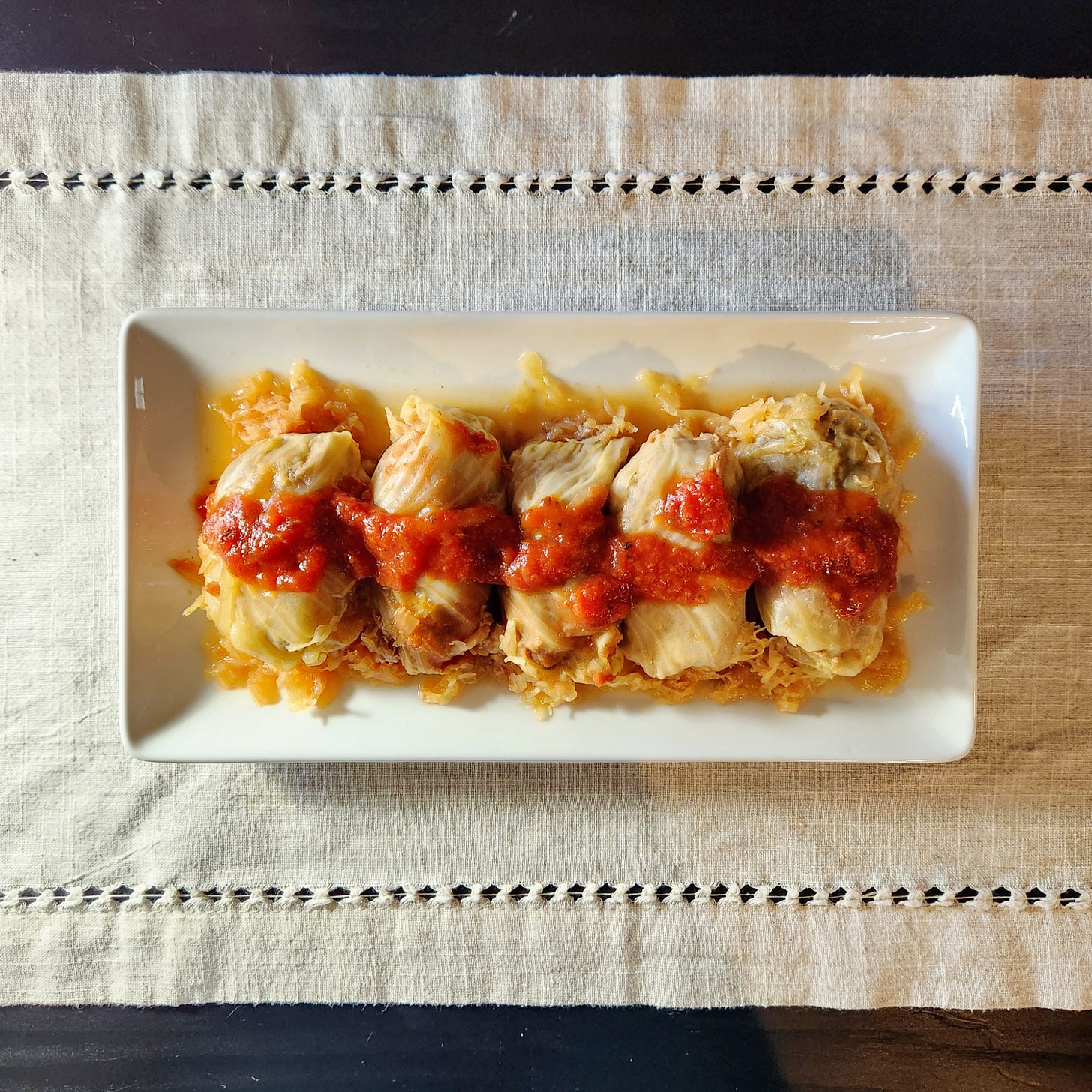I have 1 more recipe to share with you for this genealogy-adjacent series, Family Recipe Box, and then we’ll be back to our not-so-regularly scheduled family history programming. Today, we’re featuring Pigs in Blankets.
This recipe comes to us by way of Nan Kidder, who is a member of the Eckert and McMahan families and married into the Kidder fam.
Nan’s mother, Carolyn McMahan, made cabbage rolls as a special occasion dish for New Year; the tradition is now carried on by her daughters.
Get the downloadable + printable version of this recipe (PDF)
About Pigs in a Blanket
Variations of cabbage rolls are common in cuisines across Europe, including but not limited to sarma from the Balkans, gołąbki from Poland, holubtsi from Ukraine, and Jewish holishkes.
In the U.S., the dish appears where people descend from immigrants from these places — including Ohio, home state of the Eckert and McMahan families, where they are commonly called “pigs in a blanket”.
Ingredients + Equipment
6- to 8-quart slow cooker
Ground beef, 1/2 lb [see notes]
Ground Italian-seasoned chicken or turkey sausage, 1 lb lb [see notes]
Breadcrumbs, 1/4 cup
White rice, cooked, 1 1/2 cups
Onion, 1 small or about 1/2 cup, diced
Garlic, 2 cloves, minced
Eggs, 2, beaten
Salt, 2 tsp
Ground black pepper, 1/2 tsp
Paprika, 1/2 Tbsp
Cabbage, 2 small or 1 large head, separated into individual leaves
Sauerkraut, 1 jar (32 oz)
Tomato sauce, 1 can (8 oz)
Water or stock, approx. 1 cup
Instructions
Mix together the meats, breadcrumbs, rice, onion, garlic, eggs, and seasonings.
Form meat mixture into oblong balls; use a ⅓ cup measurement scoop for consistent size.
Wrap each meat ball with a leaf of cabbage. On each cabbage leaf, place a meat ball in the middle; fold the two vertical sides towards the middle over the meat, then roll up the horizontal sides.
Layer the cabbage rolls and sauerkraut in the slow cooker. Begin with a layer of plain cabbage leaves on the bottom of the pot. Put in a layer of cabbage rolls seam-side down, then top these with a layer of sauerkraut. Alternate cabbage rolls and sauerkraut until the pot is full.
Mix the tomato sauce with the water or stock, then add this liquid to the slow cooker. Use as much water or stock as needed to submerge the cabbage rolls.
Cook for 8 hours on Low or 4 hours on High.
Notes
Quantity options:
The original recipe is written for a larger number of servings; it calls for 3 pounds of meat, 2–3 heads of cabbage, 2–3 cups of cooked rice, and 4 jars of sauerkraut, as well as proportionally larger quantities of the remaining ingredients. If making more servings, you will need to either make the cabbage rolls in batches or use multiple cooking vessels.
Meat options:
If ground beef or ground poultry sausage is unavailable, ground pork or pork sausage may be substituted for either or both ingredients.
Method options:
If a slow cooker is unavailable, the cabbage rolls may be made in a heavy, lidded pot or casserole dish in an oven; cover and bake at 350° F for 1 ½ hours.
Method suggestions:
To make the cabbage leaves easier to separate and roll up, freeze the whole cabbage heads for at least 2 hours to overnight, then allow to thaw for at least 2 hours to overnight.
Alternatively, boil the cabbage for 5 minutes, then rinse with cold water or chill in an ice bath.
If it is difficult to keep the rolls neatly wrapped, consider using kitchen twine or toothpicks to hold them together. Remove these inedible items before serving.
Topping suggestions:
For extra flavor and visual appeal, serve the cabbage rolls with a tomato-based topping, such as marinara sauce.
Alternatively, sour cream is a traditional accompaniment in some cuisines.
Get the downloadable + printable version of this recipe (PDF)
Call for Comments + Family Recipes
Do you make a version of this dish?
Visit this post on Substack to comment about variations or ask questions, or just send me a note via email!
Do you have an inherited recipe to share?
If there’s a dish that’s extra special because it always made an appearance at family events or because the recipe was taught to you by an older relative, I’d love to hear about it. If you’re comfortable with sharing, I’d be happy to make the dish in my own kitchen and write it up in a shareable format, like this one — just respond to this email to reach out!



